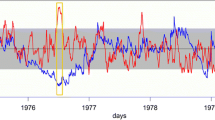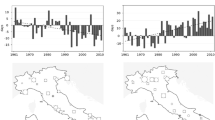Abstract
The study considers the problem of constructing a scenario forecast of changing climatic characteristics of air temperature extremes which are important for the current economy needs. Based on the numerous ensemble experiments with a high-resolution system of models, the probabilistic estimates of future changes in the applied indices of rare temperature extremes over Russia are obtained. Particular attention is given to the quantitative characteristics of uncertainty of the estimates obtained in the middle and the end of the 21st century. The important seasonal and regional features of changes in the analyzed extreme parameters are identified; they should be taken into account when adapting to climate changes at the regional level.
Similar content being viewed by others
References
M. Yu. Bardin, O. N. Bulygina, and T. V. Platova, “Extremeness of Climate,” in Second Roshydromet Assessment Report on Climate Change and Its Consequences in Russian Federation (Roshydromet, Moscow, 2014) [in Russian].
Report on Climate Features in the Russian Federation in 2016 (Roshydromet, Moscow, 2017) [in Russian].
V. M. Kattsov and B. N. Porfir’ev, “Adaptation of Russia to Climate Change: A Concept of the National Plan,” Trudy GGO, No. 586 (2017) [in Russian].
V. M. Kattsov, I. M. Shkolnik, and S. V. Efimov, “Climate Change Projections in Russian Regions: The Detailing in Physical and Probability Spaces,” Meteorol. Gidrol., No. 7 (2017) [Russ. Meteorol. Hydrol., No. 7, 42 (2017)].
M. R. Leadbetter, G. Lindgren, and H. Rootzen, Extremes and Related Properties of Random Sequences and Processes (Mir, Moscow, 1989) [Transl. from English].
E. I. Khlebnikova and T. A. Datsyuk, “Construction, Land Transport, Fuel and Energy Sector,” in Second Roshydromet Assessment Report on the Climate Change and Its Consequences in Russian Federation (Roshydromet, Moscow, 2014) [in Russian].
E. I. Khlebnikova and I. A. Sall’, “Cold Temperature Extremes in Russia and Risks of Critical Temperature Impacts on Infrastructure Facilities,” Meteorol. Gidrol., No. 6 (2018) [Russ. Meteorol. Hydrol., No. 6, 43 (2018)].
E. I. Khlebnikova, I. A. Sall’, and I. M. Shkol’nik, “Regional Climate Changes as the Factors of Impact on the Objects of Construction and Infrastructure,” Meteorol. Gidrol., No. 12 (2012) [Russ. Meteorol. Hydrol., No. 11–12, 37 (2012)].
I. M. Shkolnik, V. A. Govorkova, I. L. Karol’, A. A. Kiselev, V. P. Meleshko, E. D. Nadezhina, and T. V. Pavlova, “Expected Climate Changes on the Territory of the Russian Federation in the 21st Century,” in Second Roshydromet Assessment Report on the Climate Change and Its Consequences in Russian Federation (Roshydromet, Moscow, 2014) [in Russian].
I. M. Shkolnik, V. P. Meleshko, S. V. Efimov, and E. N. Stafeeva, “Changes in Climate Extremes on the Territory of Siberia by the Middle of the 21st Century: An Ensemble Forecast Based on the MGO Regional Climate Model,” Meteorol. Gidrol., No. 2 (2012) [Russ. Meteorol. Hydrol., No. 2, 37 (2012)].
L. V. Alexander, “Global Observed Long-term Changes in Temperature and Precipitation Extremes: A Review of Progress and Limitations in IPCC Assessments and Beyond,” Weather and Climate Extremes, 11 (2016).
S. Brown, J. Caesar, and C. Ferro, “Global Changes in Extreme Daily Temperature since 1950,” J. Geophys. Res., 113 (2008).
N. Cristidis, P. Stott, G. Brown, G. Hegerl, and J. Caesar, “Detection of Changes in Temperature Extremes during the Second Half of the 20th Century,” Geophys. Res. Lett., 32 (2005).
P. de Wilde and D. Coley, “The Implications of a Changing Climate for Buildings,” Building and Environment, 55 (2012).
H. Douvolle, J. Colin, E. Krug, J. Cattiaux, and S. Thao, “Midlatitude Daily Summer Temperatures Reshaped by Soil Moisture under Climate Change,” Geophys. Res. Lett., No. 2, 43 (2016).
T. Du, L. Xiong, C. Xu, C. Gippel, S. Guo, and P. Liu, “Return Petiod and Risk Analysis of Nonstationary Low-flow Series under Climate Change,” J. Hydrol., 527 (2015).
D. R. Easterling, K. E. Kunkel, M. F. Wehner, and L. Sun, “Detection and Attribution of Climate Extremes in the Observed Record,” Weather and Climate Extremes, 11 (2016).
R. W. Katz, “Statistics of Extremes in Climate Change,” Climatic Change, 100 (2010).
E. J. Kendon, D. P. Rowell, R. G. Jones, and E. Buonomo, “Robustness of Future Changes in Local Precipitation Extremes,” J. Climate, 21 (2008).
V. V. Kharin and F. W. Zwiers, “Changes in the Extremes in an Ensemble of Transient Climate Simulations with a Coupled Atmosphere-Ocean GCM,” J. Climate, No. 2, 13 (2000).
V. V. Kharin, F. W. Zwiers, X. Zhang, and M. Wehner, “Changes in Temperature and Precipitation Extremes in the CMIP5 Ensemble,” Climatic Change, No. 2, 119 (2013).
Y.-H. Kim, S.-K. Min, X. Zhang, F. Zwiers, L. V. Alexander, M. G. Donat, and Y.-S. Tung, “Attribution of Extreme Temperature Changes during 1951–2010,” Climatic Dynamics, 46 (2016).
E. Kodra, K. Steinhaeuser, and A. R. Ganguly, “Persisting Cold Extremes under 21st Century Warming Scenarios,” Geophys. Res. Lett., 38 (2011).
Managing the Risks of Extreme Events and Disasters to Advance Climate Change Adaptation. A Special Report of Working Groups I and II of the Intergovernmental Panel on Climate Change, Ed. by C. B. Field, V. Barros, T. F. Stocker, D. Qin, D. J. Dokken, K. L. Ebi, M. D. Mastrandrea, K. J. Mach, G.-K. Plattner, S. K. Allen, M. Tignor, and P. M. Midgley (Cambridge Univ. Press, Cambridge, UK and New York, NY, USA, 2010).
H. Rootzen and R. W. Katz, “Design Life Level: Quantifying Risk in a Changing Climate,” Water Resour. Res., 49 (2013).
S. Scherrer, E. Fischer, R. Posselt, M. Liniger, M. Croci-Maspoli, and R. Knutti, “Emerging Trends in Heavy Precipitation and Hot Temperature Extremes in Switzerland,” J. Geophys. Res. Atmos., 121 (2016).
I. Shkolnik, T. Pavlova, S. Efimov, and S. Zhuravlev, “Future Changes in Peak River Flows across Northern Eurasia as Inferred from an Ensemble of Regional Climate Projection under the IPCC RCP8.5 Scenario,” Clim. Dyn., 50 (2018).
J. Sillmann, T. Thorarinsdottir, N. Keenlyside, N. Schaller, L. V. Alexander, G. Hegerl, S. I. Seneviratne, R. Vautard, X. Zhang, and F. W. Zwiers, “Understandtng, Modeling and Predicting Weather and Climate Extremes: Challenges and Opportunities,” Weather and Climate Extremes, 18 (2017).
H. Storch and F. W. Zwiers, Statistical Analysis in Climate Research (Cambridge Univ. Press, 2002).
K. E. Taylor, R. J. Stouffer, and G. A. Meehl, “An Overview of CMIP5 and the Experiment Design,” Bull. Amer. Meteorol. Soc., 93 (2012).
D. P. van Vuuren, J. Edmonds, M. Kainuma, K. Riahi, A. Thomson, K. Hibbard, G. C. Hurtt, T. Kram, V. Krey, J.-F. Lamarque, T. Masui, M. Meinshausen, N. Nakicenovic, S. I. Smith, and S. Rose, “The Representative Concentration Pathways: An Overview,” Climatic Change, 109 (2011).
World Meteorological Organization. Guide to Climatological Practices (WMO-No. 100) (Geneva, 2011).
World Meteorological Organization. Guidelines on Analysis of Extremes in a Changing Climate in Support of Informed Decisions for Adaptation (WCDMP-72) (Geneva, 2009).
X. Zhang, J. Wang, F. W. Zwiers, and P. Y. Groisman, “The Influence of Large-scale Climate Variability on Winter Maximum Daily Precipitation over North America,” J. Climate, 23 (2010).
F. W. Zwiers, L. V. Alexander, G. C. Hegerl, T. R. Knutson, J. P. Kossin, P. Naveau, N. Nicholls, C. Schar, S. I. Seneviratne, and X. Zhang, “Climate Extremes: Challenges in Estimating and Understanding Recent Changes in the Frequency and Intensity of Extreme Climate and Weather Events,” in Climate Science for Serving Society: Research, Modelling and Prediction Priorities, Ed. by G. R. Asrar and J. W. Hurrell (Springer, Geneva, 1982).
F. W. Zwiers, X. Zhang, and J. Feng, “Anthropogenic Influence on Long Return Period Daily Temperature Extremes at Regional Scales,” J. Climate, 24 (2011).
Author information
Authors and Affiliations
Corresponding author
Additional information
Russian Text © E.I. Khlebnikova, Yu.L. Rudakova, I.A. Sall’, S.V. Efimov, I.M. Shkolnik, 2019, published in Meteorologiya i Gidrologiya, 2019, No. 3, pp. 11–24.
About this article
Cite this article
Khlebnikova, E.I., Rudakova, Y.L., Sall’, I.A. et al. Changes in Indicators of Temperature Extremes in the 21st Century: Ensemble Projections for the Territory of Russia. Russ. Meteorol. Hydrol. 44, 159–168 (2019). https://doi.org/10.3103/S1068373919030014
Received:
Revised:
Accepted:
Published:
Issue Date:
DOI: https://doi.org/10.3103/S1068373919030014




